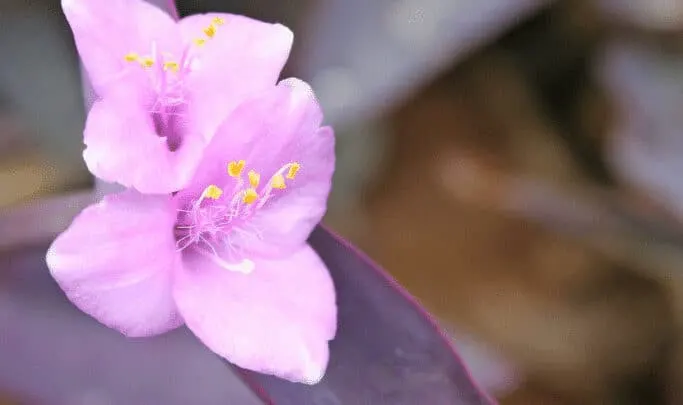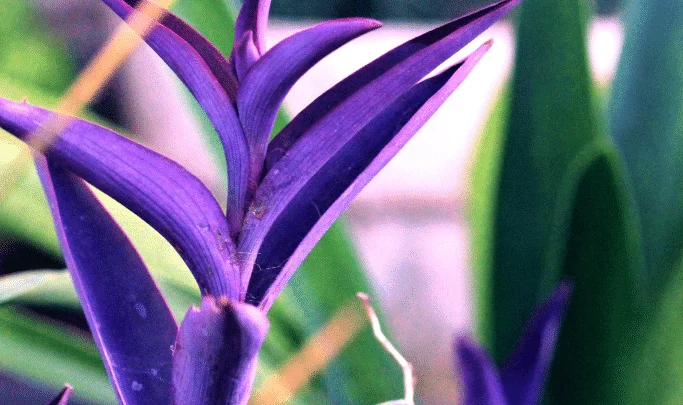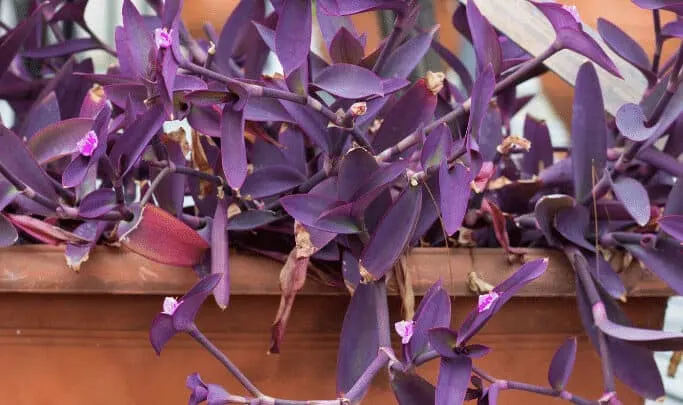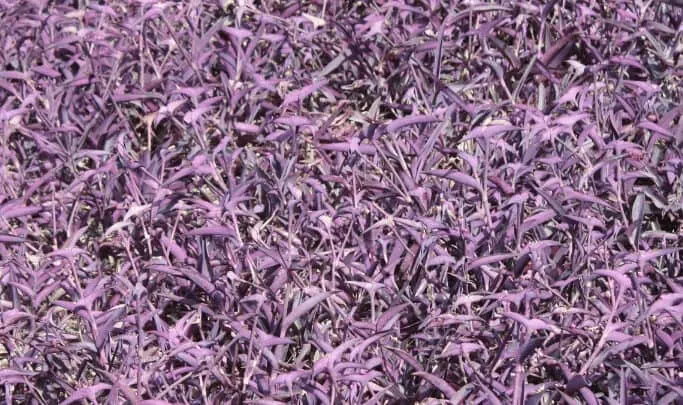Surprisingly, most plant owners prefer to include this species in their collection for the foliage rather than the flowers.
The blooms are pretty in themselves, ranging from violet to pink, but the stems and leaves are more vibrant.
Purple Heart Plant care is easy and you will certainly be successful in keeping them alive and rich in color when their basic needs are met.
In this article, I will list all the requirements in terms of plant care based on my personal experience with this plant as well as suggestions from other growers.
Purple Heart Plant Care
To care for Purple Heart plants use light well-draining soil using peat moss, perlite, and compost. Provide lots of bright indirect sunlight. Keep the temperature between 46-79 °F (18-26°C). Humidity between 40-50% is optimal. Water when the top 1-inch (1.5cm) of soil is dry about once a week. Fertilize using a balanced fertilizer with an NPK of 10-10-10 or 5-5-5 diluted to half-strenght every two weeks in spring and summer. Reduce to once a month in autumn and winter.

Purple Heart Plant Care
Table of Contents
INDOOR PURPLE HEART PLANT CARE BASICS
Classified under the perennials, the Purple Heart plant is able to come back for multiple seasons.
Growing them indoors increases their chances of holding onto that brilliant purple foliage throughout the year.
The following categories offer insights as to what these plants prefer for an optimal environment.
SOIL
Purple Heart plants prefer soil that is lightweight and porous containing peat moss, perlite, and compost.
Most commercial potting mixes will suffice.
Or you can choose to use one specifically made for plants with a similar growth pattern.
Most agree that potting soil made for African Lilies is working well.
An important factor to note is that there should be drainage holes on the bottom of the container or pot so that the soil does not retain the water.

Purple Heart Plant blooming
LIGHT
Purple Heart plants prefer bright indirect light. 3-4 hours of direct light is fine as well and won’t harm the plant.
An east or west-facing window would be the ideal location in your home.
Do you ever wonder how those purple stems stay so brightly colored?
Well, it can be mostly attributed to the amount of sunlight.
Purple Heart plants that are placed in a place with plenty of light are more likely to hold on to that violet hue.
You’ll want to introduce your Tradescantia pallida to these bright conditions in increments over time to avoid foliage burn.
The plant, as a whole, can also thrive in partial shade outdoors, but the stems shift to a greener color.
WATERING
The Purple Heart plant is known to be drought-tolerant, making watering an easier chore.
Full-grown Purple Heart plants will not need any water until the top 1-inch (2.5 cm) of soil feels dry to the touch.
Although they can survive for long stints without being saturated, these individuals still need a regular schedule.
The younger plants will require more water than adults, typically once a week.
TEMPERATURE
Purple Heart plants grow best in temperatures between 46-79 °F (18-26°C)
According to the University of Wisconsin, Tradescantia pallida is hardy in USDA hardiness zones 7-10.
Tradescantia pallida is pretty average as far as temperature requests go.
People who keep their Purple Hearts outside have to face the challenge of sudden frosts, most often bringing their plants in during the winter.
Indoor individuals don’t have this problem.
Be careful not to let this temperature drop below 59°F (15°C) as this will stunt its growth and might harm the plant if it is exposed to these conditions for several hours.

Striking purple foliage of the Purple Heart Plant. The adaxial and abaxial side of the leaf blade are both purple.
HUMIDITY
Purple Heart plant needs humidity between 40-50% to thrive.
The average humidity for a house is anywhere from 40 to 50 percent.
This is the perfect amount for a Purple Heart plant.
Dry air affects the leaves, often leaving them limp.
If your house is unusually dry, then you may want to consider investing in a humidifier.
Placing your Purple Heart in the bathroom or kitchen can also solve this problem.
FERTILIZER
To fertilize the Purple Heart plant use a balanced liquid fertilizer with an NPK of 10-10-10 or 5-5-5 at half-strength once every two weeks in spring and summer. Reduce to once a month in autumn and winter.
The purpose of adding a fertilizer to your plant’s soil is to provide the individual with nutrients that it might be lacking.
It can also help increase the growth of flowers.
PROPAGATION
You can propagate a Purple Heart plant through a number of propagation techniques such as division, stem cuttings, and transplanting.
Choosing to hold onto a particularly vibrant individual through propagation isn’t a bad idea.
Out of all of these methods, stem cuttings are the least amount of hassle.
If you need a step-by-step guide for how to successfully propagate your Purple Heart, we’ll have a section later on.

A Purple Heart Plant growing outside
GROWTH
Labeled as a “creeping perennial”, the Purple Heart plant spreads out as it grows.
Adults usually reach anywhere from 8 to 12 inches tall with a width that covers 16 inches.
Compared to most indoor plants, they have a relatively fast growth rate.
POTTING
These plants aren’t known to grow all that large, making repotting an infrequent process.
The only time that you will need to transfer it to a new container is if the roots have grown to push through the drainage holes located on the underside.
This typically happens during spring. Keep a close eye on your plant at this time, examining the bottom for such creeping.
FLOWERING
The purple heart plant develops 3-petaled flowers with a pink color in summer that has a diameter of 1-5 inches (3.8 cm) according to the University of Arizona.
PURPLE HEART PLANT WATERING SPECIFICATIONS
The consensus about the Purple Heart plant and its need for water is simply that this is relatively low.
In reality, this species doesn’t need a frequently implemented watering schedule. Not compared amongst other indoor flowering plants.
Understanding how much to give your Tradescantia pallida might be tricky.
Err on the side of too much water and you will damage the roots.
Too little will result in a less vibrant plant. To make it easier, we’ve compiled the advice of Purple Heart enthusiasts.
WHEN NOT TO WATER
The Purple Heart plant does not need constant watering. They instead do better when a seasonal watering schedule is implemented.
Although it may seem wrong, watering more often between certain time periods is better for the overall health of your indoor Tradescantia.
The months that you should add water are from early spring through fall.
During this time, you’ll likely your Purple Heart about once a week. The remainder of the year, only provide moisture every week.

A sea of Tradescantia pallida
EXTREME HEAT OR DROUGHT
When there is a long period of high temperatures or drought, you may want to consider upping the amount of water that you supply your Purple Heart plant with.
Although species are drought-tolerant, they still need extra care when presented with these conditions.
Those who experience high temperatures in their home should water these plants twice a week.
PURPLE HEART PLANT PROPAGATION
Making a copy of your beloved Tradescantia pallida doesn’t have to be that difficult.
Compared to other plants, this is a short process. Keeping in mind that they are labeled as toxic, you may want to consider equipping yourself with gloves.
Stem cuttings are the easiest of the techniques, and only take a few weeks to see results.
Read the section below for a detailed step-by-step guide on how to go about cloning your prized Purple Heart plant.
PROPAGATION THROUGH STEM CUTTINGS
- Choose which individual you would like to clone, preferably one that keeps its color throughout the year and has healthy blooms.
- Thoroughly water the plant and let it dry overnight. A plant that is watered beforehand will yield more successful cuttings.
- Take clean scissors and make an incision in the stem about 4 inches long, making sure that there are two or three leaves. It’s best to make this cutting either in the morning or evening when it isn’t too warm. The stem should also be cut right under a bud.
- Place the stem cuttings, open section down, into a pot with freshly laid soil.
- Water the individual thoroughly and keep checking back over the next few weeks for roots to start forming. When this happens, transfer it carefully to a new container.
PRUNING A PURPLE HEART PLANT
The Purple Heart plant is known for the long beautiful stems that grow to be quite long.
Due to how quickly they grow, it doesn’t take long for this plant to become leggy and spindly, taking over your room.
Pruning should be done in the warmer months, once all the flowers have properly bloomed.
To go about pruning your Purple Heart plant, you should use sharp scissors and use gloves.
They are classified as being toxic to people, dogs, and cats when consumed.
For the best results, take off the top half of the stems that are overgrown.
SIGNS THAT A PURPLE HEART PLANT DESPAIRS
Being prepared for any potential problems that may arise with your Purple Heart plant is pivotal in maintaining a healthy individual.
Although relatively healthy, these individuals can have a few issues.
The most common ailments that you might see with Purple Heart plants are below.
TELLTALE SIGN #1: LEAVES TURNING GREEN
Cause: For most plants, green foliage signifies that the plant is doing well. This isn’t the case for the Purple Heart.
Sunlight is usually the problem. A shift from purple too green can mean that it isn’t getting enough sunlight.
Remedy: This may seem contrary to what you’ve been taught about plants, but a Purple Heart with green leaves should be placed in direct, full sunlight, but slowly and only for a short time!
The foliage is at risk for the leaves to become burned, so make sure to move it once the color has changed back to a violet hue.
TELLTALE SIGN #2: BROWNING OF THE LEAVES
Cause: As you may have guessed, looking at the color of the leaves is a great indicator the plant’s overall health.
Green leaves are due to a lack of sunshine. Brown leaves, on the other hand, are likely because of there isn’t enough moisture.
Remedy: This problem is relatively easy to fix. A lack of moisture should first be addressed by checking the existent humidity.
If you think it’s low, use a mister to add water without oversaturating.
After trying this without success, you can adjust the watering schedule. Just don’t overdo it.
FIVE ESSENTIAL TRICKS TO A HEALTHY PURPLE HEART
Tradescantia pallida is a very unique treasure to include in your home.
But, without that iconic purple coloring, it looks defeated and dull.
Keeping your Purple Heart plant happy and healthy is easy when you look at its basic needs.
For a final takeaway, we have compiled a list of the most important tricks for a more vibrant plan.
- Use lightweight soil that can drain properly for your plant. There should be drainage holes on the bottom of the container so that it doesn’t sit in water, which would cause root rot.
- Be bold with the sun exposure. Purple Heart plants prefer full sun exposure to maintain their vibrancy. Do this gradually to avoid the leaves becoming burned.
- The average household should have a good temperature range for these plants. Avoid letting them sit in a room that hits below 10 degrees Celsius.
- Given the fact that these plants, rather quickly, routinely check to see if the roots are sprouting through the drainage holes and act accordingly.
- Don’t feel obligated to use fertilizer unless the plant needs a nutrient boost. If you do add it, dilute the solution to half its strength.
Read about the Purple Waffle Plant care next.
FREQUENTLY ASKED QUESTIONS ABOUT THE PURPLE HEART PLANT
Is the Purple Heart plant invasive?
These plants are considered to be an invasive species. They’re originally native to Eastern Mexico, but landscaping has boosted their landscaping.
Is a Purple Heart Plant a perennial?
The Purple Heart plant is indeed a perennial, as it lives multiple seasons. The flowers do tend to die off in winter, but quickly return with the proper amount of care.
What are the benefits of owning a Purple Heart plant?
Depending on the culture, Tradescantia pallida can be used in a variety of ways. For instance, those in Taiwan strongly think that it can help with inflammatory issues. Others believe it to be an antioxidant.

Daniel has been a plant enthusiast for over 20 years. He owns hundreds of houseplants and prepares for the chili growing seasons yearly with great anticipation. His favorite plants are plant species in the Araceae family, such as Monstera, Philodendron, and Anthurium. He also loves gardening and is growing hot peppers, tomatoes, and many more vegetables.


